|
With the arrival of Spring finally approaching, people's thoughts turn to
three things; tilling the soil, Crappie fishing, and turkey hunting. Since
gardening involves a lot of work, and we aren't allowed to shoot fish in Tennessee, we will
deal here with the subject of turkey hunting: specifically the shotgun chokes
used therein.
In the pursuit of the wild turkey, a lot of
time and effort is involved leading up to the time that the hunter actually
shoots his turkey. Everything up to the pulling of the trigger we will ignore
for purposes of this particular article. What we will concentrate on here is
delivering the load of shot to the target.
First of all, in turkey hunting, the firing
of the gun is more akin to rifle shooting than it is to most of the shotgun
sports. A turkey gun is aimed, rather than pointed. Many hunters mount optical
sights or open rifle-type sights on their turkey guns. This is where practice
with a patterning board can really pay off. A successful hunter needs to know
where his shotgun shoots in relation to where the sights are pointing.
The next thing, and equally important,
is to be able to deliver the shot, or a portion thereof, to the vital head and
neck region of the turkey. A wild turkey needs to be hit right and hit hard, with
at least a few pellets of number 6 or larger shot to insure a good kill. I
prefer number 5 or 4 shot to insure good penetration. Number 6 shot loses velocity faster
and doesn't weigh as much, per pellet, as the larger sizes. If you could hit
the turkey with the full payload of a magnum shell, it doesn't matter what the shot size. But
patterns being what they are, a few pellets will hit the bird, but most will
miss.
Many hunters choose to get the shell with the heaviest payload to insure
more pellets flying toward the target, logically putting more pellets into the
bird. But, with the heaviest payloads, there is a trade off. Velocity is sacrificed for the sake of
putting more pellets in the air. Slower pellets just do not hit as hard as
faster ones. That's why I prefer the high-velocity turkey loads. They do have fewer pellets in
the load, but deliver them with more energy per pellet to the target. As an
added bonus, in my experience I have found that percentage wise, the lighter
payload shells pattern better.
All of this finally leads us to the subject
of this article: obtaining the best, tightest patterns possible from a turkey
gun. I recently received for testing two screw-in chokes made specifically for
that purpose. Both chokes happen to be made in Sylvania, Georgia. One is called the
Comp-N-Choke, the other is Kick's Industries Gobblin' Thunder. Both chokes are
intended to provide better patterns while at the same time, by virtue of their different
ports, reduce felt recoil.
I pattern tested both chokes, along with another choke that has proven to
provide good patterns, at 40 yards with Winchester Magnum Turkey shells. These are premium, buffered,
hard-shot loads with a good reputation in the turkey woods.
Both the Comp-N-Choke and the Gobblin' Thunder provided excellent
patterns from my 3 inch Mossberg 500. As to whether the ports reduced felt recoil, I can't really say. That
lightweight pump gun kicks pretty hard with any serious turkey load, but I will
take them at their word that it does reduce felt recoil. After an afternoon of
shooting the Mossberg from a benchrest, my shoulder is the same color as the rest of me, without a trace
of blue or purple bruising.
With either of these chokes in your turkey gun, you can deliver a good,
tight pattern of shot into the vital area of a turkey, if you do your part.
You can contact Comp-N-Choke toll free by phone at:
1-888-875-7906 or on the web at www.comp-n-choke.com.
You can contact Kick's Industries at: 1-800-587-2779 and
www.kicks-ind.com.
So much preparation and skill goes into getting a shot at a wild turkey,
that it just doesn't make sense to have the hunt fail due to a poorly performing
choke. Try one of these chokes with a good load of high-velocity number four
hard shot, and pulling the trigger will become the easiest part of turkey hunting.
Jeff Quinn
  
Got something to say about this article? Want to agree (or
disagree) with it? Click the following link to go to the GUNBlast Feedback Page.
All content © 2001 GunBlast.com.
All rights reserved. |
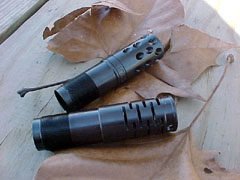
At top is Kick's Industries' Gobblin' Thunder, at bottom is the
Comp-N-Choke.
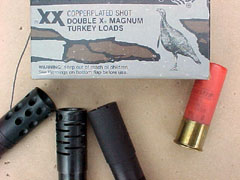
From left to right: Kicks Gobblin' Thunder, Comp-N-Choke,
and the author's trusty (non-ported) Hastings tube.
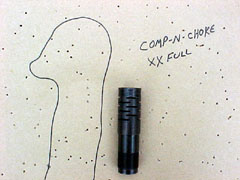
Pattern demonstrates excellent shot coverage with the Comp-N-Choke.
Range was 40 yards.
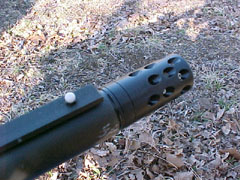
Kick's Industries' Gobblin' Thunder, installed on the author's
Mossberg 500.
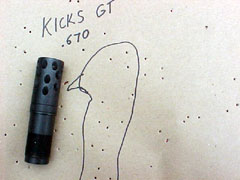
Kicks Industries' Gobblin' Thunder demonstrated slightly more
focused pattern with somewhat thinner shot coverage.
|
![]()